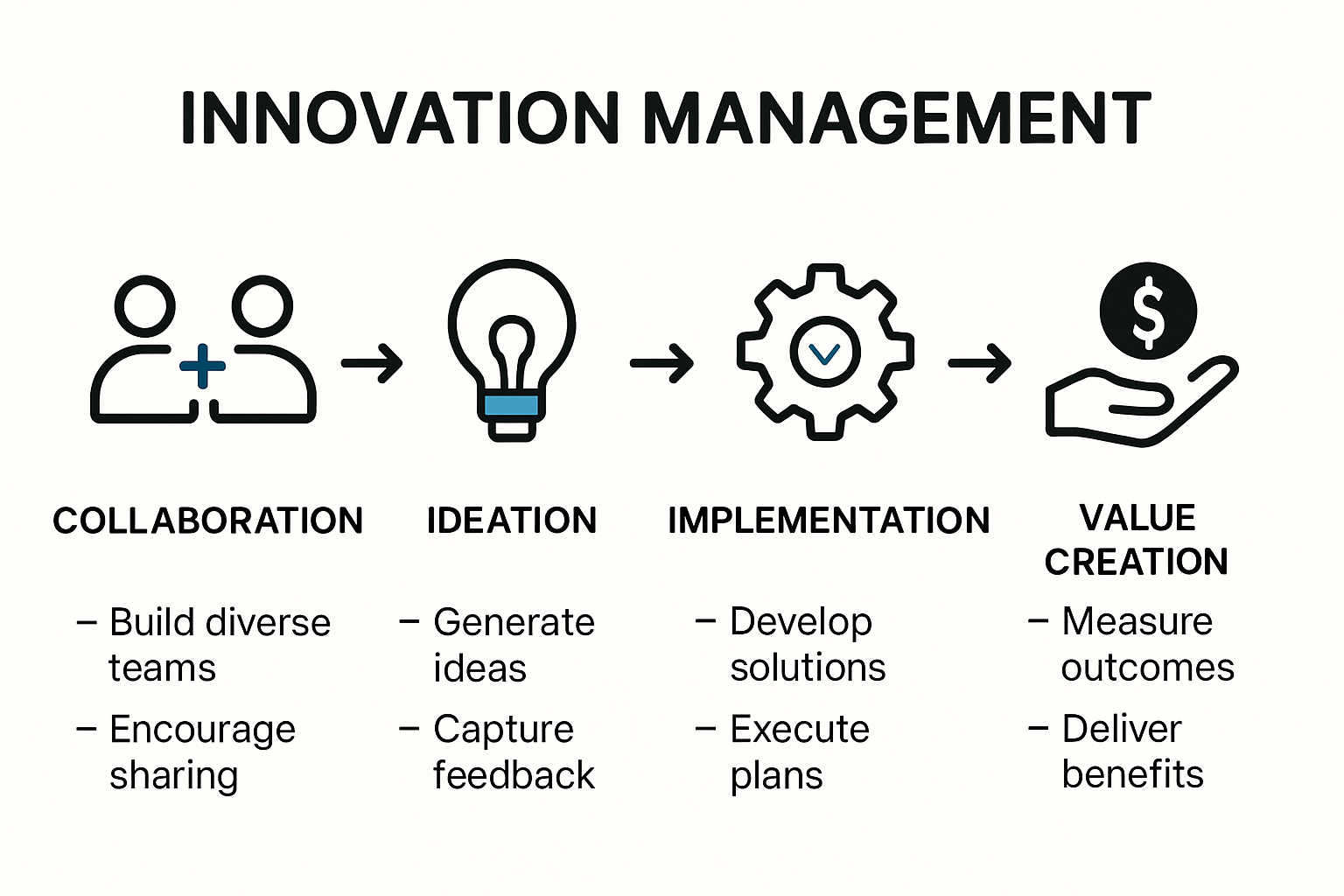


Innovation Management Definition: Meaning, Process and Value
Innovation management is everywhere in business talk these days and everyone seems to agree it’s a secret weapon for success. Yet did you know that over 70 percent of innovation efforts actually fail to deliver lasting results? That sounds shocking, but the reality is that most organizations misunderstand what innovation management really means. The real difference is not about chasing big, flashy ideas but about creating a repeatable process where every team member plays a part and failure turns into fuel for learning.
Table of Contents
- What Innovation Management Definition Means
- Core Elements of Innovation Management
- Why Innovation Management Matters for Organizations
- Steps to Build Effective Innovation Management
Quick Summary
| Takeaway | Explanation |
|---|---|
| Innovation management is a structured process. | It involves intentional frameworks to foster creativity and implement ideas effectively within organizations. |
| Create a collaborative culture for innovation. | Encouraging teamwork and breaking down silos allows for diverse ideas and better execution across the organization. |
| Align innovation with organizational goals. | A clear strategic vision connects innovative efforts to overall business objectives, ensuring focused and relevant initiatives. |
| Implement customer-centric innovation processes. | Understanding customer needs through feedback and market research drives relevant innovation and enhances market positioning. |
| View failure as a learning opportunity. | Encouraging risk-taking and viewing setbacks as learning experiences fosters a resilient and adaptive organizational culture. |
What Innovation Management Definition Means
Innovation management is a sophisticated strategic discipline that transforms how organizations approach creative problem solving and organizational growth. At its core, innovation management represents a systematic approach to generating, developing, and implementing new ideas that drive competitive advantage and sustainable progress.
The Fundamental Essence of Innovation Management
Innovation management is not merely about generating random ideas but creating a structured ecosystem where creative thinking can flourish strategically. According to EBSCO Research Starters, it involves “establishing processes and environments where innovative thought can flourish, such as brainstorming sessions and collaborative practices.”
This definition encompasses several critical components. First, it recognizes innovation as a deliberate process rather than a spontaneous occurrence. Organizations must intentionally design frameworks that encourage creative thinking, break down traditional departmental barriers, and create safe spaces for employees to propose and explore unconventional solutions.
Systemic Approach to Organizational Innovation
As Springer Research explains, innovation management is “the process of handling the development of a product or service, including successful market launch.” This definition highlights the comprehensive nature of innovation management that extends beyond ideation to practical implementation.
The systemic approach involves multiple interconnected stages: idea generation, concept development, prototyping, testing, refinement, and strategic deployment. Each stage requires careful management, cross-functional collaboration, and a willingness to embrace calculated risks. Successful innovation management transforms abstract concepts into tangible solutions that create real value for organizations.
Strategic Implications and Organizational Transformation
Beyond process, innovation management represents a profound organizational philosophy. Management Research suggests that management innovation involves “generating and implementing new solutions concerning processes, rules, methods, and structures,” fundamentally reimagining how organizational goals are pursued.
This perspective positions innovation management as more than a department or strategy—it becomes a cultural mindset. Organizations committed to robust innovation management recognize that competitive advantage emerges not just from breakthrough products but from continuous adaptive capacity. They create environments where experimentation is encouraged, failure is viewed as a learning opportunity, and employees at all levels are empowered to contribute transformative ideas.
Explore our comprehensive guide on managing innovation portfolios to understand how leading organizations are redefining their approach to strategic innovation.
Core Elements of Innovation Management
Innovation management is a complex ecosystem comprising interconnected elements that transform organizational potential into tangible strategic advantages. Understanding these core elements enables leaders to create robust frameworks that consistently generate and implement groundbreaking solutions.
Strategic Vision and Organizational Alignment
At the foundation of effective innovation management lies a clear strategic vision. According to the National Institute of Standards and Technology, successful innovation requires establishing “a clear and compelling vision that aligns innovation initiatives with organizational goals.” This means creating a comprehensive roadmap that connects creative efforts directly to broader business objectives.
Key components of strategic vision include defining innovation priorities, identifying potential innovation domains, and establishing measurable goals. Organizations must develop a nuanced understanding of their current capabilities while simultaneously exploring emerging opportunities. Leadership plays a critical role in communicating this vision, ensuring that every team member understands how their innovative contributions support the overarching organizational strategy.
Collaborative Culture and Systematic Processes
The Federal Reserve Bank of St. Louis highlights four essential elements of innovation management: collaboration, ideation, implementation, and value creation. Central to these elements is creating an environment that encourages cross-functional teamwork and breaks down traditional organizational silos.

Collaborative innovation management requires establishing structured processes that facilitate idea generation, evaluation, and execution. This involves creating safe spaces for experimentation, implementing transparent decision-making mechanisms, and developing robust feedback loops. Organizations must design systematic approaches that transform creative concepts into actionable projects, balancing creative freedom with strategic discipline.
Organizational Culture and Performance Enablers
Research from the Arizona Board of Regents reveals eight critical elements of an innovative organizational culture. These include developing democratic communication channels, creating psychological safety for risk-taking, implementing flexible thinking frameworks, and establishing incentive structures that reward innovative behavior.
Performance enablers are crucial in sustaining innovation momentum. This involves developing knowledge management systems, promoting continuous learning, and creating performance metrics that recognize both successful innovations and valuable learning experiences from unsuccessful attempts. Leaders must cultivate an environment where failure is viewed as a necessary component of the innovation journey.
Learn more about building comprehensive innovation management strategies to transform these core elements into tangible organizational capabilities.
Why Innovation Management Matters for Organizations
Innovation management represents a critical strategic imperative for organizations seeking to thrive in increasingly complex and competitive global environments. It transcends traditional business practices by providing a structured approach to generating, evaluating, and implementing transformative ideas that drive sustainable growth and competitive advantage.
Driving Organizational Adaptability and Resilience
In an era of rapid technological disruption and evolving market dynamics, organizations must develop robust mechanisms for continuous adaptation. According to the National Institute of Standards and Technology, effective innovation management empowers organizations to “cultivate game-changing ideas by fostering a culture of continuous improvement and involving employees in the innovation process.”
This approach enables organizations to proactively respond to emerging challenges rather than reactively addressing market shifts. By establishing systematic innovation frameworks, companies can develop organizational agility that allows them to pivot quickly, identify emerging opportunities, and mitigate potential risks before they become critical threats. Innovation management transforms uncertainty from a potential liability into a strategic resource for organizational growth.
Performance Enhancement and Competitive Positioning
Research from the National Center for Biotechnology Information highlights that innovation strategies are crucial for enhancing organizational performance and maintaining competitiveness across various sectors. Innovation management provides a structured approach to converting creative potential into tangible business value, enabling organizations to differentiate themselves in crowded marketplaces.
Key performance benefits include accelerated product development cycles, improved operational efficiency, enhanced customer satisfaction, and the ability to create unique value propositions. By systematically managing innovation, organizations can develop a repeatable process for generating breakthrough solutions that address complex challenges and create sustainable competitive advantages.
Strategic Knowledge Management and Organizational Learning
The National Academies Press emphasizes that the innovation process involves “generating ideas, evaluating them, focusing on viable ones, and scaling them,” which underscores the importance of systematic innovation management for organizational success.
Beyond immediate business outcomes, innovation management serves as a powerful mechanism for organizational learning and knowledge development. It creates structured channels for capturing institutional knowledge, promoting cross-functional collaboration, and developing a culture of continuous improvement. By establishing clear processes for idea generation, evaluation, and implementation, organizations can transform individual insights into collective intelligence.
Discover strategies for building a comprehensive innovation management approach that can revolutionize your organization’s innovative potential.
Steps to Build Effective Innovation Management
Building effective innovation management is a strategic journey that requires deliberate planning, organizational commitment, and a systematic approach to transforming creative potential into tangible business value. Organizations must develop a comprehensive framework that enables consistent innovation across all operational levels.
Establishing a Robust Innovation Architecture
According to the MIT Sloan Management Review, successful innovation management comprises five essential stages: idea generation and mobilization, advocacy and screening, experimentation, commercialization, and diffusion and implementation. These stages create a structured pathway for transforming innovative concepts into actionable strategies.
Here is a table summarizing the main stages of the innovation management process as described by the MIT Sloan Management Review. This table helps clarify each stage’s purpose and sequence in building effective innovation management.
| Stage | Description |
|---|---|
| Idea generation and mobilization | Coming up with creative ideas and gathering input from across the organization |
| Advocacy and screening | Evaluating ideas and selecting the most promising ones for further development |
| Experimentation | Testing selected ideas through prototypes, pilots, or other experiments |
| Commercialization | Preparing successful innovations for market launch or broader organizational implementation |
| Diffusion and implementation | Spreading and embedding the innovation throughout the company or relevant markets |
The first critical step involves creating an organizational infrastructure that supports innovation. This includes establishing clear governance mechanisms, defining innovation roles and responsibilities, and developing transparent processes for idea submission, evaluation, and implementation. Leaders must design systems that encourage participation from employees across all hierarchical levels, ensuring that innovative thinking is not confined to specific departments but becomes a company-wide endeavor.
Cultivating an Innovative Organizational Culture
EDUCAUSE Review emphasizes the importance of fostering a culture of innovation through continuous improvement and strategic cultural transformation. Key elements include creating a compelling value statement, incorporating core competencies, and fundamentally changing how ideas are discussed and evaluated within the organization.
Cultural development requires creating psychological safety where employees feel empowered to share unconventional ideas without fear of ridicule or professional repercussions. This involves implementing reward systems that recognize innovative thinking, establishing cross-functional collaboration mechanisms, and promoting a growth mindset that views failure as a learning opportunity rather than a setback.
Implementing Customer-Centric Innovation Processes
The Harvard Division of Continuing Education recommends a four-step process that centers innovation around customer needs: observing customers to uncover new problems and opportunities, creating targeted solutions, prototyping and learning in the market, and implementing the most promising ideas.
This customer-centric approach requires developing robust feedback mechanisms, conducting continuous market research, and maintaining flexibility in innovation strategies. Organizations must invest in tools and technologies that facilitate rapid prototyping, enable data-driven decision-making, and support iterative development processes. By maintaining a close connection with customer experiences and emerging market trends, companies can ensure that their innovation efforts remain relevant and impactful.

Explore our comprehensive guide to innovation portfolio management to gain deeper insights into building a world-class innovation management framework.
Frequently Asked Questions
What is innovation management?
Innovation management is a structured process that allows organizations to systematically generate, develop, and implement new ideas to drive competitive advantage and sustainable growth.
Why is innovation management important for organizations?
Innovation management is crucial because it helps organizations adapt to market changes, enhance performance, and maintain competitiveness by transforming creative potential into actionable business value.
What are the core elements of innovation management?
The core elements of innovation management include strategic vision and organizational alignment, collaborative culture and systematic processes, and performance enablers that support innovation initiatives.
How can organizations build an effective innovation management system?
Organizations can build an effective innovation management system by establishing a robust innovation architecture, cultivating an innovative organizational culture, and implementing customer-centric innovation processes.
Transform Your Innovation Strategy from Theory to Impact
Are you struggling to turn innovation talk into real, measurable value? Many organizations fall short because they lack a structured process and the right tools to manage the full innovation cycle. The article highlights that even with a clear strategic vision and a collaborative culture, most teams still miss out on repeatable success due to inconsistent frameworks, missed learning from failure, and poor alignment with business goals.

Experience a platform specifically designed to address these challenges. Skipso delivers the infrastructure you need to run high-impact programs and create a true system for innovation management. From generating ideas to launching solutions, our platform supports every phase discussed in this article. Ready to move from definition to action? Discover how Skipso can help you align innovation with your organization’s goals and build a culture that thrives on progress.
Explore our guide to innovation portfolio management for practical next steps, then visit Skipso’s homepage and start building your effective innovation management system today.
Recommended













